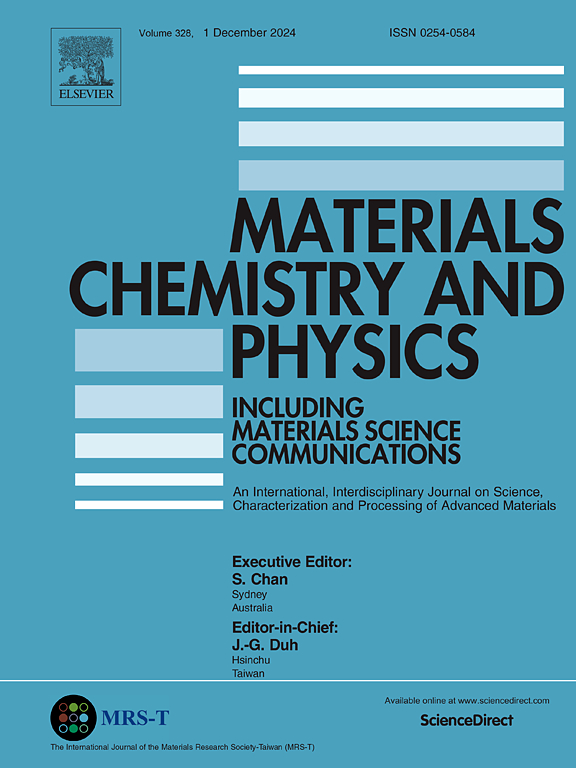A compressible asymmetric supercapacitor based on carbon Felt/MWCNT@PANI and MXene
IF 4.7
3区 材料科学
Q2 MATERIALS SCIENCE, MULTIDISCIPLINARY
引用次数: 0
Abstract
Compressible supercapacitors are novel energy storage devices for commercial portable and flexible electronics. Substantial efforts have been made to develop compressible supercapacitors with high voltage output, good mechanical stability, and electrochemical performance. This study investigates the performance of a compressible asymmetric supercapacitor configuration based on a polyaniline-modified carbon felt/multi-walled carbon nanotube composite (a-CF/MWCNT@PANI) as the positive electrode and a titanium carbide-MXene (Ti3C2Tx) as the negative electrode. The acid-functionalized MWCNTs were loaded into activated carbon felt by dipping and drying and subsequently were coated by polyaniline via the chemical oxidation polymerization method. Fourier transform infrared spectroscopy (FTIR), scanning electron microscopy (SEM), and X-ray photoelectron spectroscopy (XPS) confirmed the formation of the dendritic structure of PANI on the surface of 3D porous composite (a-CF/MWCNT@PANI) positive electrode. X-ray diffraction (XRD), SEM, and cyclic voltammetry (CV) measurements revealed 2D layered morphology and pseudocapacitive behavior of Ti3C2Tx-MXene. The specific capacitance of the assembled asymmetric supercapacitor was found as 1.6 F cm−2 at 5 mA cm−2, the corresponding energy density and power density were 262 μWh cm−2 and 2.7 mW cm−2, respectively. The asymmetric cell exhibited a retention rate of 92.4 % after 1000 cycles. Above 50 % strain, the supercapacitor showed a favorable CV profile, which is owing to the enhanced electrical conductivity of the CF composite electrode caused by compression. The capacitance retention retained more than 90 % over 200 compression-recovery cycles.

基于碳毡/MWCNT@PANI和MXene的可压缩非对称超级电容器
可压缩超级电容器是一种适用于商用便携式和柔性电子产品的新型储能装置。可压缩超级电容器具有高电压输出、良好的机械稳定性和电化学性能。本文研究了以聚苯胺改性碳毡/多壁碳纳米管复合材料(a- cf /MWCNT@PANI)为正极,以碳化钛- mxene (Ti3C2Tx)为负极的可压缩非对称超级电容器结构的性能。通过浸渍和干燥将酸功能化的MWCNTs装入活性炭毡中,然后通过化学氧化聚合方法将聚苯胺包被。傅里叶变换红外光谱(FTIR)、扫描电镜(SEM)和x射线光电子能谱(XPS)证实了三维多孔复合材料(a-CF/MWCNT@PANI)正极表面形成聚苯胺枝晶结构。x射线衍射(XRD)、扫描电镜(SEM)和循环伏安法(CV)测量揭示了Ti3C2Tx-MXene的二维层状形貌和赝电容行为。在5ma cm - 2下,所制备的非对称超级电容器的比电容为1.6 F cm - 2,相应的能量密度为262 μWh cm - 2,功率密度为2.7 mW cm - 2。经过1000次循环后,非对称细胞的保留率为92.4%。在50%应变以上,超级电容器表现出良好的CV曲线,这是由于压缩导致CF复合电极的电导率增强。在200次压缩恢复循环中,电容保持率保持在90%以上。
本文章由计算机程序翻译,如有差异,请以英文原文为准。
求助全文
约1分钟内获得全文
求助全文
来源期刊

Materials Chemistry and Physics
工程技术-材料科学:综合
CiteScore
8.70
自引率
4.30%
发文量
1515
审稿时长
69 days
期刊介绍:
Materials Chemistry and Physics is devoted to short communications, full-length research papers and feature articles on interrelationships among structure, properties, processing and performance of materials. The Editors welcome manuscripts on thin films, surface and interface science, materials degradation and reliability, metallurgy, semiconductors and optoelectronic materials, fine ceramics, magnetics, superconductors, specialty polymers, nano-materials and composite materials.
 求助内容:
求助内容: 应助结果提醒方式:
应助结果提醒方式:


